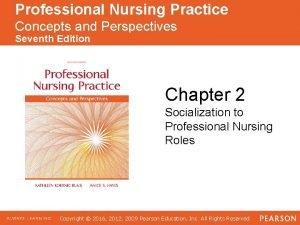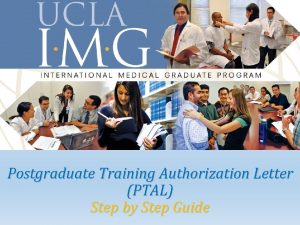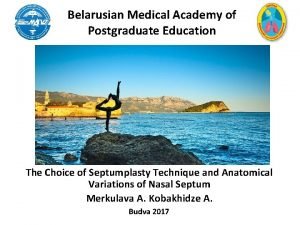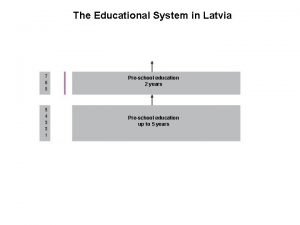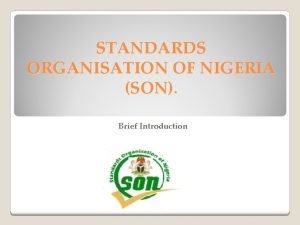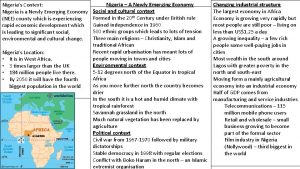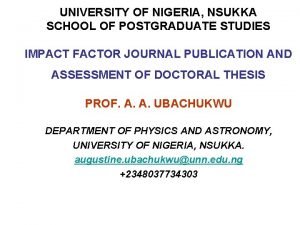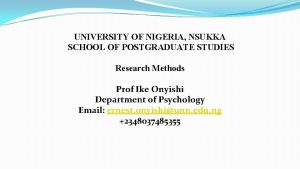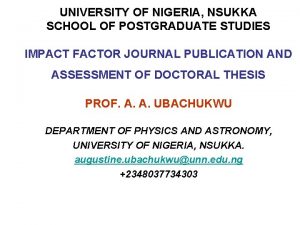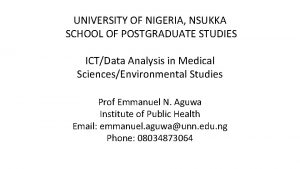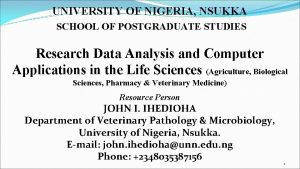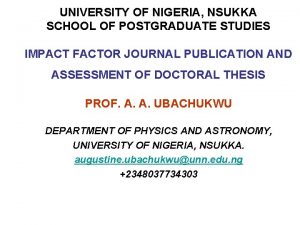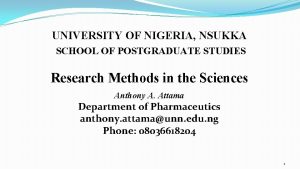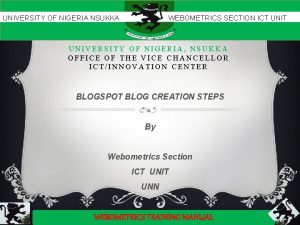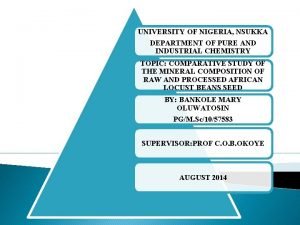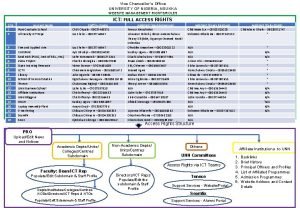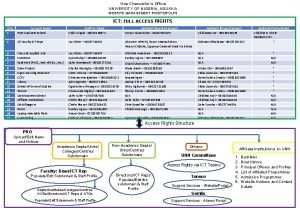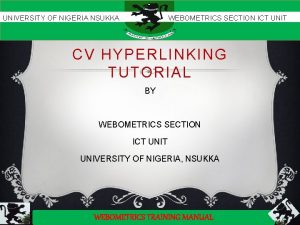UNIVERSITY OF NIGERIA NSUKKA SCHOOL OF POSTGRADUATE STUDIES



























- Slides: 27

UNIVERSITY OF NIGERIA, NSUKKA SCHOOL OF POSTGRADUATE STUDIES Research Methods in the Sciences Resource Person JOHN I. IHEDIOHA Department of Veterinary Pathology & Microbiology, University of Nigeria, Nsukka. E-mail: john. ihedioha@unn. edu. ng Phone: +2348035387156 1


GOALS AND OBJECTIVES At the end of this presentation, you (the participants) would have been informed and enlightened on: v What Research is, and the Goals, Purposes and Uses of Research. v The Principles and Standard Steps involved in the Scientific method of Research. v The Categories of Research and Classification of Research Studies in the Sciences. v Identification of Research Funders, and the Qualities and Characteristics of a good Researcher. 3

1. INTRODUCTION – What is Research? Research literally means ‘to study or investigate closely and thoroughly’ (deriving from its French etymology). Definition of Research systematic and exhaustive search for new knowledge or new interpretation of an existing knowledge. 4

1. INTRODUCTION – What is Research? contd.

2. USES OF RESEARCH Research is used to: Ø Establish or confirm facts. Ø Re-affirm the results of previous work. Ø Solve new or existing problems. Ø Support theorems, or develop new theories. Ø Expand on past work in a field of study. Ø Test the validity of instruments, procedures, or experiments. 6



4 b. RESEARCH PRINCIPLES - Background to a Study or Justification v The background to a study is a documentation of the historical development and the current state of knowledge of the topic under investigation. v Information for the background of a study can be obtained by reviewing relevant literature, that is, looking through relevant books, journals, conference abstracts and proceedings, thesis, dissertation and project reports etc. v The background to a study must identify the pivotal work that led to the one being proposed for investigation and highlight the ‘knowledge gap’ or ‘gap in understanding’ which the present proposed study is out address or fill in. Hence the other name for background to a study is Justification for a Study. 9

4 c. RESEARCH PRINCIPLES – Statement of the Problem v. The statement of the research problem outlines/defines the problem that the study/research aims to tackle – it is a claim (in one, two or three sentences) that outlines the problem to be addressed by the study. v A good statement of problem should specify variables which can be compared, correlated or observed, and delimit the scope of the investigation. v The statement of the problem should answer the question: what is the problem that the research is to address? 10

4 d. RESEARCH PRINCIPLES – Research Questions q Research questions are answerable inquiries into a specific research topic. q They are questions that must be raised to which the research or investigation should be geared towards solving. q Research questions arise from the statement of the problem, and the general purpose of the study/work will be to find answers to these research questions. 11

4 d. RESEARCH PRINCIPLES – Research Questions contd. Steps in writing a good research question: i. Specify the research topic. ii. Decide what you want to know about the topic. iii. Turn what you want to know and the specific topic into a question. iv. Ensure that the question is answerable. v. Check to make sure that the question is not too broad or too narrow. 12

4 e. RESEARCH PRINCIPLES – Hypothesis for a Study v A hypothesis is defined as a testable prediction which designates the relationship between two or more variables. v It is a conjecture or tentative assumption subject to rejection or confirmation based on further or more facts. v In most research works, a specific hypothesis has to be stated - each hypothesis may take one aspect of research 13

4 e. RESEARCH PRINCIPLES – Hypothesis for a Study contd. v A hypothesis may be a Null or Alternative hypothesis. 14

4 f. RESEARCH PRINCIPLES – Aims and Objectives of a Study The aim of a study is a broad statement of the general intentions of the research or what the investigator intends to study – it should be clearly and concisely defined. The objectives of a study (often known as specific objectives) are the specific breakdown statements of the components of the overall aim or purpose of the study – the objectives are subsidiary to the overall aim. The objectives are the specific steps that the investigator is going to take to answer his/her research questions or the specific list of tasks that are needed to accomplish the goals of the research project. 15

4 g. RESEARCH PRINCIPLES – Significance of a Study q The significance of a study usually explains the significance of the research project, its potential benefits and its possible overall impacts. q The significance of a study explains why the research project was worth being done; that is why it is also known as the ‘rationale’. q The significance of the study should also examine what impact the study might have, not just on the academic or scientific community, but also on the general public. q It should present practical benefits, such as how the work might inform policy, improve some aspects of people's lives, make for greater efficiency or help the environment. 16

4 g. RESEARCH PRINCIPLES – Significance of a Study A statement of the significance of the study highlights: ü Why the research work is important, ü The possible implications of the findings, ü How the study might fill in knowledge gaps in the area of study, ü How the expected outcome of the study shall impact on society generally, and/or, ü Point the way towards further study. 17

5. STEPS IN CONDUCTING RESEARCH – The Scientific Method v The scientific method is a body of techniques for investigating phenomena, acquiring new knowledge, or correcting and integrating previous knowledge, which is based on empirical and measurable evidence subject to specific principles of reasoning. v Involves systematic observation, measurement, and experiment, and the formulation, testing, and modification of hypothesis. v Basic expectations in scientific method - Document, archive and share all data and methodology so that they are available for careful scrutiny by other scientists, giving them the opportunity to verify results by attempting to reproduce them. This practice, called full disclosure, also allows statistical measures of the reliabilty of these data to be established. 18

5. STEPS IN CONDUCTING RESEARCH 19

6 a. CATEGORIZATION OF RESEARCH 20

6 b. FURTHER CATEGORIZATION OF RESEARCH QUALITATIVE Research QUANTITATIVE Research 21

7. CLASSIFICATION OF RESEARCH STUDIES 22

8. SOURCES OF FUNDING FOR RESEARCH v Funding for scientific research comes principally from: Ø Governments (TETfund Nigeria, Grand Challenges Canada, National Institutes of Health USA, Medical Research Council UK, etc), Ø Corporate research and development departments (WHO, UNO, FAO, ILRI, IITA), and Ø Private foundations/individuals (Bill and Melinda Gates Foundation, Thrasher Research Fund, You and I etc). 23

9. QUALITIES OF A GOOD RESEARCHER 24

HANDS-ON EXERCISES 1. In your research area, seek out three research concepts, and for each, carefully note down the Background/Justification for the study, Statement of Problem, Research Questions, Hypothesis of the Study, Aims and Objectives, and Significance of the Study. 2. Go to your Departmental or Faculty Library, pick up 25 dissertations/thesis, and classify the research appropriately into Experimental (True & Quasi Experiments) and Observational Studies (Cohort, Cross. Sectional or Case-Control studies). 25

SUMMARY OF WHAT WAS PRESENTED! v What Research is, and What it is not. v Uses, Goals and Purposes of Research as a tool for the advancement of knowledge and tackling the myriad of human problems. v Research Principles, the Scientific Method and Steps in Conducting Research. v Categories and Classifications of Research Studies. v Outline of Research Funders and What makes for a Good Researcher. 26

27
 Ajou university graduate school
Ajou university graduate school Jane jacobs columbia university school of general studies
Jane jacobs columbia university school of general studies Kramer's postgraduate resocialization model
Kramer's postgraduate resocialization model Seoul university acceptance rate
Seoul university acceptance rate English authorization letter
English authorization letter Difference between postgraduate and undergraduate
Difference between postgraduate and undergraduate Difference between postgraduate and undergraduate
Difference between postgraduate and undergraduate Susi grant limits
Susi grant limits Clinical governance postgraduate
Clinical governance postgraduate Belarusian medical academy of postgraduate education
Belarusian medical academy of postgraduate education Postgraduate education
Postgraduate education Alexmed postgraduate
Alexmed postgraduate Paradigm shift from women studies to gender studies
Paradigm shift from women studies to gender studies Herszon kherson maritime college of merchant marine fleet
Herszon kherson maritime college of merchant marine fleet The bucharest university of economic studies ranking
The bucharest university of economic studies ranking Beijing foreign studies university accommodation
Beijing foreign studies university accommodation Standards organisation of nigeria logo
Standards organisation of nigeria logo Laws guiding book publishing in nigeria
Laws guiding book publishing in nigeria Nigeria newly emerging economy
Nigeria newly emerging economy Universities that offer pharmacy in nigeria
Universities that offer pharmacy in nigeria Meaning of llb and bl in nigeria
Meaning of llb and bl in nigeria Environmental policy in nigeria
Environmental policy in nigeria Gifmis nigeria
Gifmis nigeria Xxxvideo cameroon
Xxxvideo cameroon History of community development
History of community development Máscara de cultura isoko nigeria
Máscara de cultura isoko nigeria Bernabe nwoye
Bernabe nwoye White fathers in nigeria
White fathers in nigeria


